Intercultural Communication: Imperatives, Barriers, and Relationships
VerifiedAdded on 2022/08/17
|7
|1428
|22
Essay
AI Summary
This essay delves into the multifaceted realm of intercultural communication, examining its imperatives, barriers, and various communication styles. It identifies economic, technological, and ethical factors as key imperatives, and analyzes how ethnocentrism, stereotyping, prejudice, and discrimination impede effective communication. The essay also defines and explores the potential of third culture communication styles, highlighting the benefits and challenges of interpersonal intercultural relationships. Furthermore, it discusses the impact of these relationships on cross-cultural communication and contrasts identity development between minority and majority group members within the United States. The essay concludes with references to relevant academic sources, providing a comprehensive overview of intercultural communication concepts.
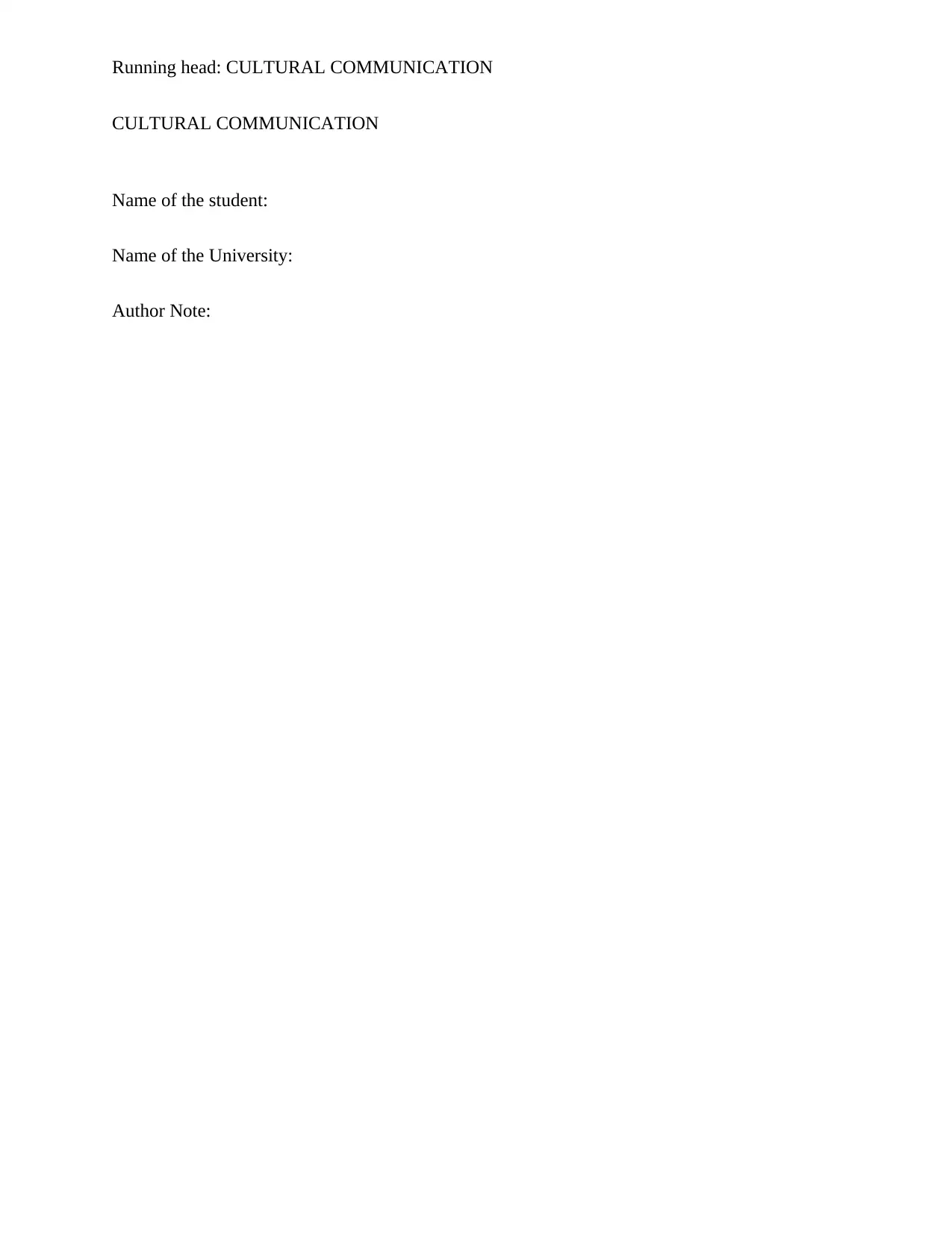
Running head: CULTURAL COMMUNICATION
CULTURAL COMMUNICATION
Name of the student:
Name of the University:
Author Note:
CULTURAL COMMUNICATION
Name of the student:
Name of the University:
Author Note:
Paraphrase This Document
Need a fresh take? Get an instant paraphrase of this document with our AI Paraphraser
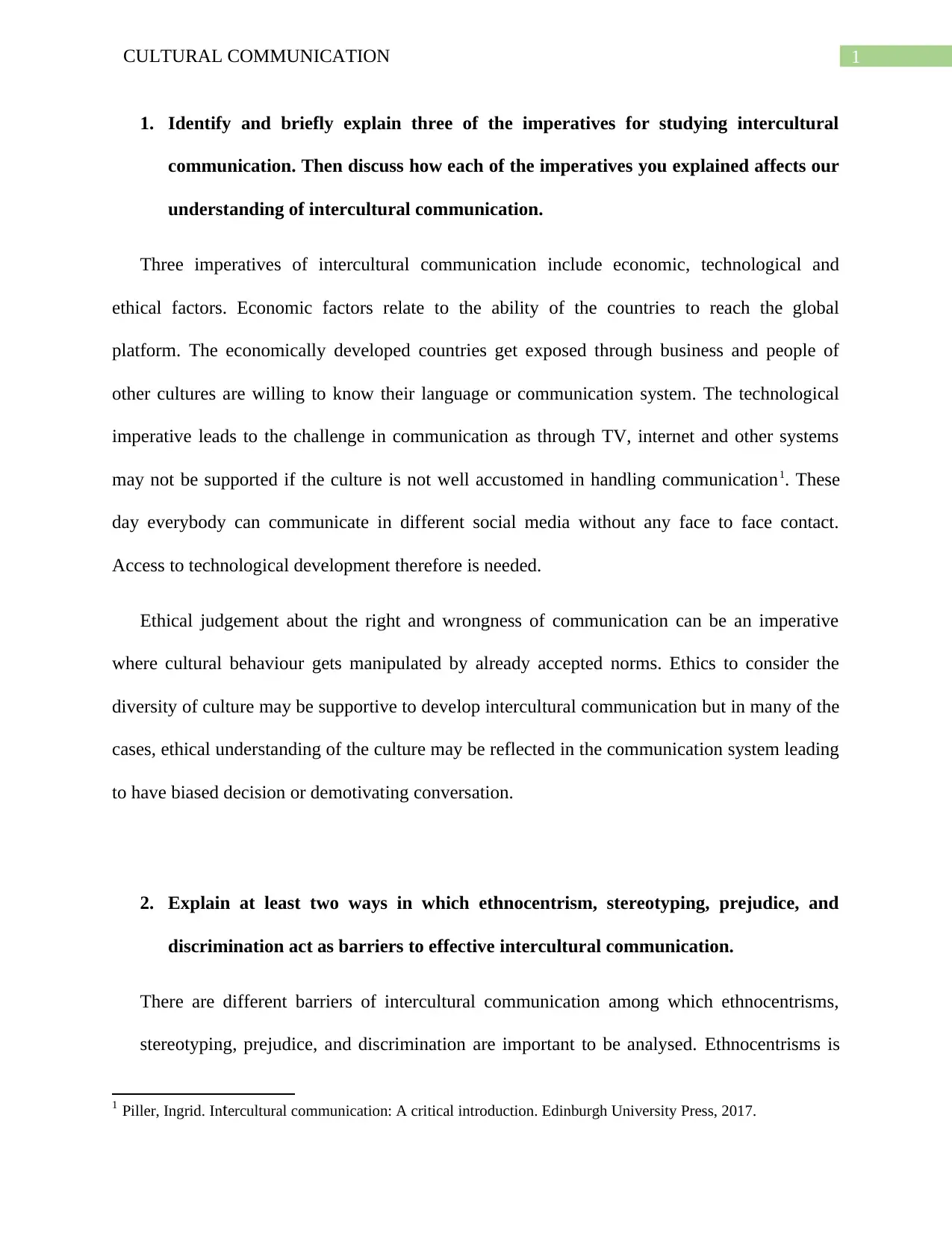
1CULTURAL COMMUNICATION
1. Identify and briefly explain three of the imperatives for studying intercultural
communication. Then discuss how each of the imperatives you explained affects our
understanding of intercultural communication.
Three imperatives of intercultural communication include economic, technological and
ethical factors. Economic factors relate to the ability of the countries to reach the global
platform. The economically developed countries get exposed through business and people of
other cultures are willing to know their language or communication system. The technological
imperative leads to the challenge in communication as through TV, internet and other systems
may not be supported if the culture is not well accustomed in handling communication1. These
day everybody can communicate in different social media without any face to face contact.
Access to technological development therefore is needed.
Ethical judgement about the right and wrongness of communication can be an imperative
where cultural behaviour gets manipulated by already accepted norms. Ethics to consider the
diversity of culture may be supportive to develop intercultural communication but in many of the
cases, ethical understanding of the culture may be reflected in the communication system leading
to have biased decision or demotivating conversation.
2. Explain at least two ways in which ethnocentrism, stereotyping, prejudice, and
discrimination act as barriers to effective intercultural communication.
There are different barriers of intercultural communication among which ethnocentrisms,
stereotyping, prejudice, and discrimination are important to be analysed. Ethnocentrisms is
1 Piller, Ingrid. Intercultural communication: A critical introduction. Edinburgh University Press, 2017.
1. Identify and briefly explain three of the imperatives for studying intercultural
communication. Then discuss how each of the imperatives you explained affects our
understanding of intercultural communication.
Three imperatives of intercultural communication include economic, technological and
ethical factors. Economic factors relate to the ability of the countries to reach the global
platform. The economically developed countries get exposed through business and people of
other cultures are willing to know their language or communication system. The technological
imperative leads to the challenge in communication as through TV, internet and other systems
may not be supported if the culture is not well accustomed in handling communication1. These
day everybody can communicate in different social media without any face to face contact.
Access to technological development therefore is needed.
Ethical judgement about the right and wrongness of communication can be an imperative
where cultural behaviour gets manipulated by already accepted norms. Ethics to consider the
diversity of culture may be supportive to develop intercultural communication but in many of the
cases, ethical understanding of the culture may be reflected in the communication system leading
to have biased decision or demotivating conversation.
2. Explain at least two ways in which ethnocentrism, stereotyping, prejudice, and
discrimination act as barriers to effective intercultural communication.
There are different barriers of intercultural communication among which ethnocentrisms,
stereotyping, prejudice, and discrimination are important to be analysed. Ethnocentrisms is
1 Piller, Ingrid. Intercultural communication: A critical introduction. Edinburgh University Press, 2017.
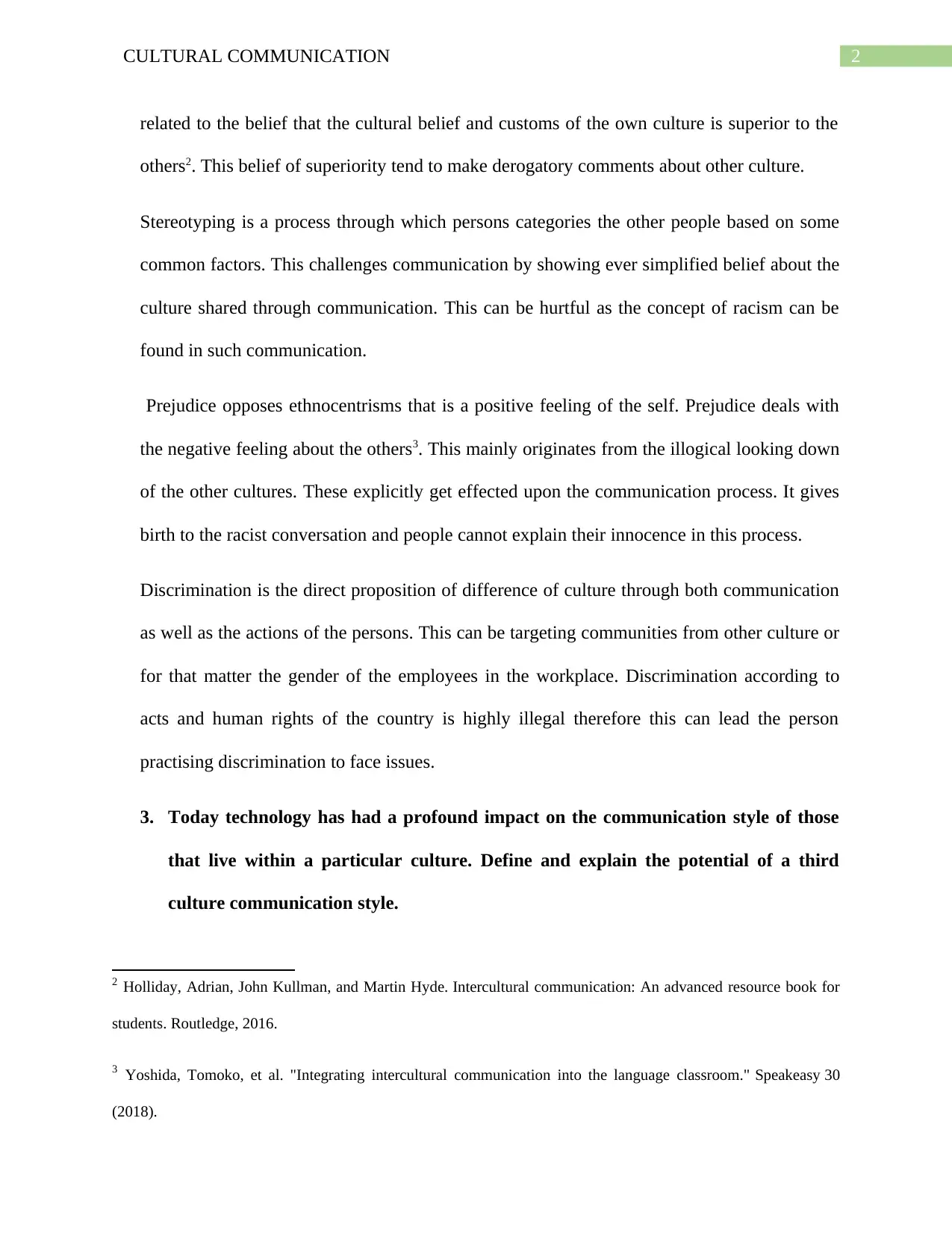
2CULTURAL COMMUNICATION
related to the belief that the cultural belief and customs of the own culture is superior to the
others2. This belief of superiority tend to make derogatory comments about other culture.
Stereotyping is a process through which persons categories the other people based on some
common factors. This challenges communication by showing ever simplified belief about the
culture shared through communication. This can be hurtful as the concept of racism can be
found in such communication.
Prejudice opposes ethnocentrisms that is a positive feeling of the self. Prejudice deals with
the negative feeling about the others3. This mainly originates from the illogical looking down
of the other cultures. These explicitly get effected upon the communication process. It gives
birth to the racist conversation and people cannot explain their innocence in this process.
Discrimination is the direct proposition of difference of culture through both communication
as well as the actions of the persons. This can be targeting communities from other culture or
for that matter the gender of the employees in the workplace. Discrimination according to
acts and human rights of the country is highly illegal therefore this can lead the person
practising discrimination to face issues.
3. Today technology has had a profound impact on the communication style of those
that live within a particular culture. Define and explain the potential of a third
culture communication style.
2 Holliday, Adrian, John Kullman, and Martin Hyde. Intercultural communication: An advanced resource book for
students. Routledge, 2016.
3 Yoshida, Tomoko, et al. "Integrating intercultural communication into the language classroom." Speakeasy 30
(2018).
related to the belief that the cultural belief and customs of the own culture is superior to the
others2. This belief of superiority tend to make derogatory comments about other culture.
Stereotyping is a process through which persons categories the other people based on some
common factors. This challenges communication by showing ever simplified belief about the
culture shared through communication. This can be hurtful as the concept of racism can be
found in such communication.
Prejudice opposes ethnocentrisms that is a positive feeling of the self. Prejudice deals with
the negative feeling about the others3. This mainly originates from the illogical looking down
of the other cultures. These explicitly get effected upon the communication process. It gives
birth to the racist conversation and people cannot explain their innocence in this process.
Discrimination is the direct proposition of difference of culture through both communication
as well as the actions of the persons. This can be targeting communities from other culture or
for that matter the gender of the employees in the workplace. Discrimination according to
acts and human rights of the country is highly illegal therefore this can lead the person
practising discrimination to face issues.
3. Today technology has had a profound impact on the communication style of those
that live within a particular culture. Define and explain the potential of a third
culture communication style.
2 Holliday, Adrian, John Kullman, and Martin Hyde. Intercultural communication: An advanced resource book for
students. Routledge, 2016.
3 Yoshida, Tomoko, et al. "Integrating intercultural communication into the language classroom." Speakeasy 30
(2018).
⊘ This is a preview!⊘
Do you want full access?
Subscribe today to unlock all pages.

Trusted by 1+ million students worldwide
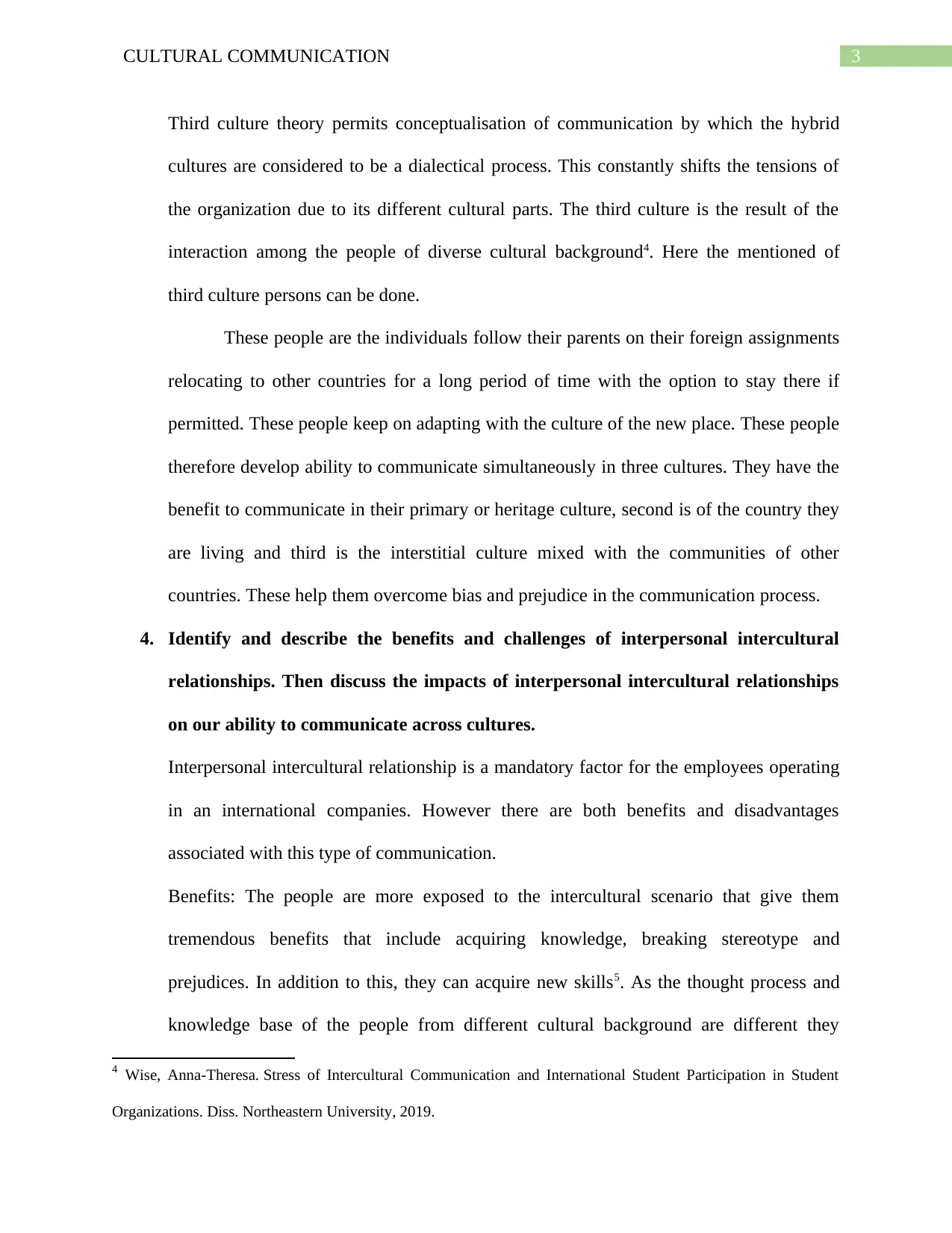
3CULTURAL COMMUNICATION
Third culture theory permits conceptualisation of communication by which the hybrid
cultures are considered to be a dialectical process. This constantly shifts the tensions of
the organization due to its different cultural parts. The third culture is the result of the
interaction among the people of diverse cultural background4. Here the mentioned of
third culture persons can be done.
These people are the individuals follow their parents on their foreign assignments
relocating to other countries for a long period of time with the option to stay there if
permitted. These people keep on adapting with the culture of the new place. These people
therefore develop ability to communicate simultaneously in three cultures. They have the
benefit to communicate in their primary or heritage culture, second is of the country they
are living and third is the interstitial culture mixed with the communities of other
countries. These help them overcome bias and prejudice in the communication process.
4. Identify and describe the benefits and challenges of interpersonal intercultural
relationships. Then discuss the impacts of interpersonal intercultural relationships
on our ability to communicate across cultures.
Interpersonal intercultural relationship is a mandatory factor for the employees operating
in an international companies. However there are both benefits and disadvantages
associated with this type of communication.
Benefits: The people are more exposed to the intercultural scenario that give them
tremendous benefits that include acquiring knowledge, breaking stereotype and
prejudices. In addition to this, they can acquire new skills5. As the thought process and
knowledge base of the people from different cultural background are different they
4 Wise, Anna-Theresa. Stress of Intercultural Communication and International Student Participation in Student
Organizations. Diss. Northeastern University, 2019.
Third culture theory permits conceptualisation of communication by which the hybrid
cultures are considered to be a dialectical process. This constantly shifts the tensions of
the organization due to its different cultural parts. The third culture is the result of the
interaction among the people of diverse cultural background4. Here the mentioned of
third culture persons can be done.
These people are the individuals follow their parents on their foreign assignments
relocating to other countries for a long period of time with the option to stay there if
permitted. These people keep on adapting with the culture of the new place. These people
therefore develop ability to communicate simultaneously in three cultures. They have the
benefit to communicate in their primary or heritage culture, second is of the country they
are living and third is the interstitial culture mixed with the communities of other
countries. These help them overcome bias and prejudice in the communication process.
4. Identify and describe the benefits and challenges of interpersonal intercultural
relationships. Then discuss the impacts of interpersonal intercultural relationships
on our ability to communicate across cultures.
Interpersonal intercultural relationship is a mandatory factor for the employees operating
in an international companies. However there are both benefits and disadvantages
associated with this type of communication.
Benefits: The people are more exposed to the intercultural scenario that give them
tremendous benefits that include acquiring knowledge, breaking stereotype and
prejudices. In addition to this, they can acquire new skills5. As the thought process and
knowledge base of the people from different cultural background are different they
4 Wise, Anna-Theresa. Stress of Intercultural Communication and International Student Participation in Student
Organizations. Diss. Northeastern University, 2019.
Paraphrase This Document
Need a fresh take? Get an instant paraphrase of this document with our AI Paraphraser
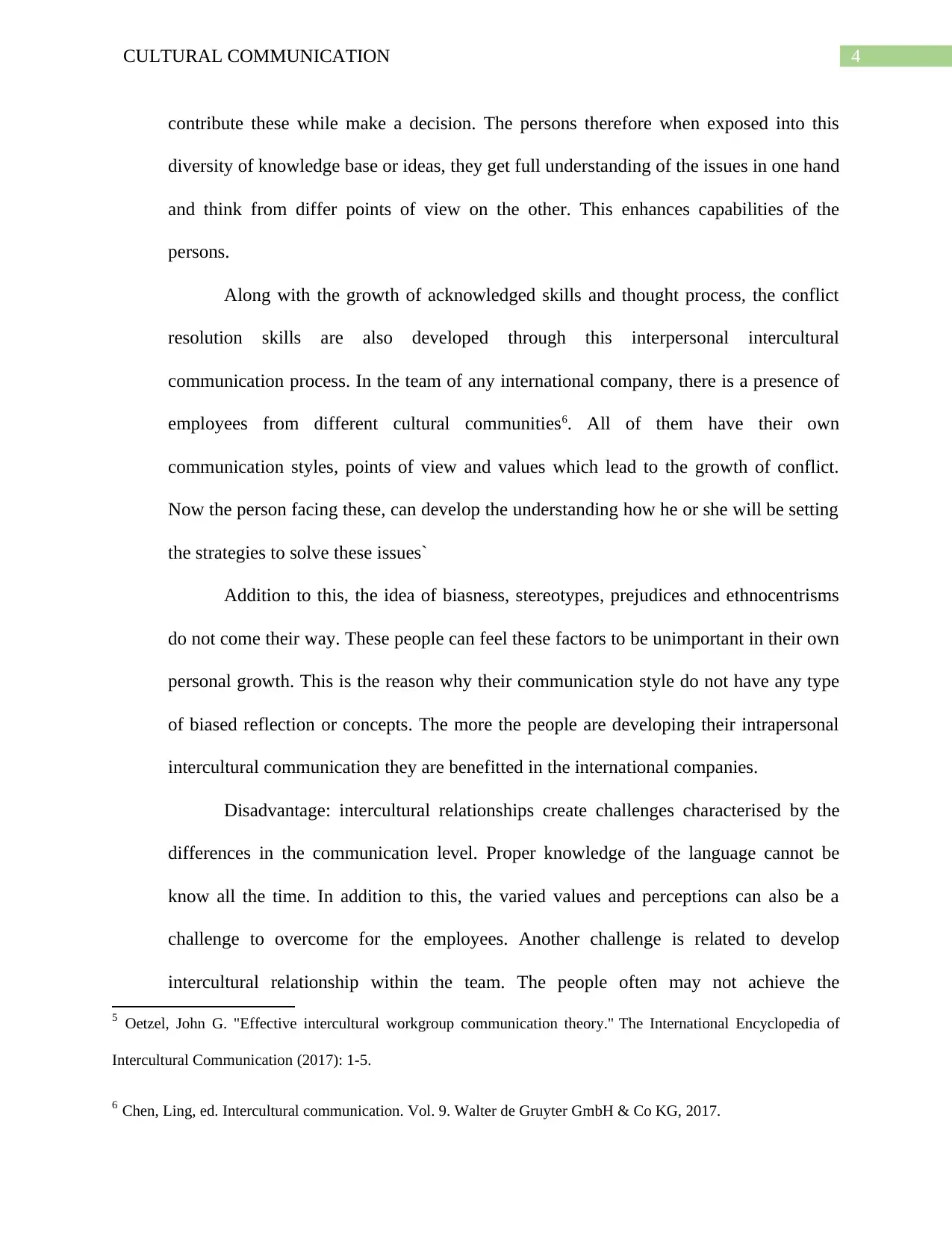
4CULTURAL COMMUNICATION
contribute these while make a decision. The persons therefore when exposed into this
diversity of knowledge base or ideas, they get full understanding of the issues in one hand
and think from differ points of view on the other. This enhances capabilities of the
persons.
Along with the growth of acknowledged skills and thought process, the conflict
resolution skills are also developed through this interpersonal intercultural
communication process. In the team of any international company, there is a presence of
employees from different cultural communities6. All of them have their own
communication styles, points of view and values which lead to the growth of conflict.
Now the person facing these, can develop the understanding how he or she will be setting
the strategies to solve these issues`
Addition to this, the idea of biasness, stereotypes, prejudices and ethnocentrisms
do not come their way. These people can feel these factors to be unimportant in their own
personal growth. This is the reason why their communication style do not have any type
of biased reflection or concepts. The more the people are developing their intrapersonal
intercultural communication they are benefitted in the international companies.
Disadvantage: intercultural relationships create challenges characterised by the
differences in the communication level. Proper knowledge of the language cannot be
know all the time. In addition to this, the varied values and perceptions can also be a
challenge to overcome for the employees. Another challenge is related to develop
intercultural relationship within the team. The people often may not achieve the
5 Oetzel, John G. "Effective intercultural workgroup communication theory." The International Encyclopedia of
Intercultural Communication (2017): 1-5.
6 Chen, Ling, ed. Intercultural communication. Vol. 9. Walter de Gruyter GmbH & Co KG, 2017.
contribute these while make a decision. The persons therefore when exposed into this
diversity of knowledge base or ideas, they get full understanding of the issues in one hand
and think from differ points of view on the other. This enhances capabilities of the
persons.
Along with the growth of acknowledged skills and thought process, the conflict
resolution skills are also developed through this interpersonal intercultural
communication process. In the team of any international company, there is a presence of
employees from different cultural communities6. All of them have their own
communication styles, points of view and values which lead to the growth of conflict.
Now the person facing these, can develop the understanding how he or she will be setting
the strategies to solve these issues`
Addition to this, the idea of biasness, stereotypes, prejudices and ethnocentrisms
do not come their way. These people can feel these factors to be unimportant in their own
personal growth. This is the reason why their communication style do not have any type
of biased reflection or concepts. The more the people are developing their intrapersonal
intercultural communication they are benefitted in the international companies.
Disadvantage: intercultural relationships create challenges characterised by the
differences in the communication level. Proper knowledge of the language cannot be
know all the time. In addition to this, the varied values and perceptions can also be a
challenge to overcome for the employees. Another challenge is related to develop
intercultural relationship within the team. The people often may not achieve the
5 Oetzel, John G. "Effective intercultural workgroup communication theory." The International Encyclopedia of
Intercultural Communication (2017): 1-5.
6 Chen, Ling, ed. Intercultural communication. Vol. 9. Walter de Gruyter GmbH & Co KG, 2017.
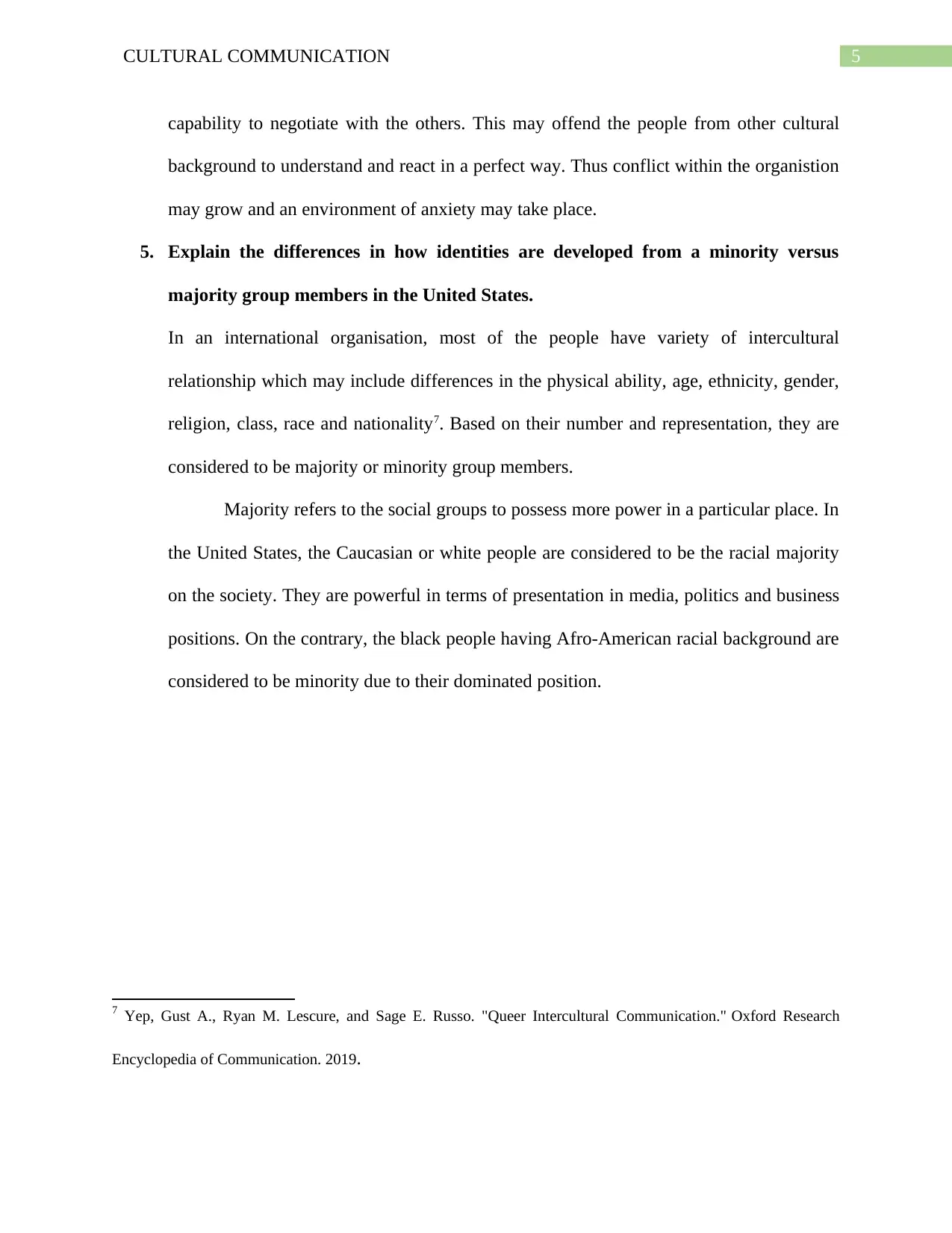
5CULTURAL COMMUNICATION
capability to negotiate with the others. This may offend the people from other cultural
background to understand and react in a perfect way. Thus conflict within the organistion
may grow and an environment of anxiety may take place.
5. Explain the differences in how identities are developed from a minority versus
majority group members in the United States.
In an international organisation, most of the people have variety of intercultural
relationship which may include differences in the physical ability, age, ethnicity, gender,
religion, class, race and nationality7. Based on their number and representation, they are
considered to be majority or minority group members.
Majority refers to the social groups to possess more power in a particular place. In
the United States, the Caucasian or white people are considered to be the racial majority
on the society. They are powerful in terms of presentation in media, politics and business
positions. On the contrary, the black people having Afro-American racial background are
considered to be minority due to their dominated position.
7 Yep, Gust A., Ryan M. Lescure, and Sage E. Russo. "Queer Intercultural Communication." Oxford Research
Encyclopedia of Communication. 2019.
capability to negotiate with the others. This may offend the people from other cultural
background to understand and react in a perfect way. Thus conflict within the organistion
may grow and an environment of anxiety may take place.
5. Explain the differences in how identities are developed from a minority versus
majority group members in the United States.
In an international organisation, most of the people have variety of intercultural
relationship which may include differences in the physical ability, age, ethnicity, gender,
religion, class, race and nationality7. Based on their number and representation, they are
considered to be majority or minority group members.
Majority refers to the social groups to possess more power in a particular place. In
the United States, the Caucasian or white people are considered to be the racial majority
on the society. They are powerful in terms of presentation in media, politics and business
positions. On the contrary, the black people having Afro-American racial background are
considered to be minority due to their dominated position.
7 Yep, Gust A., Ryan M. Lescure, and Sage E. Russo. "Queer Intercultural Communication." Oxford Research
Encyclopedia of Communication. 2019.
⊘ This is a preview!⊘
Do you want full access?
Subscribe today to unlock all pages.

Trusted by 1+ million students worldwide
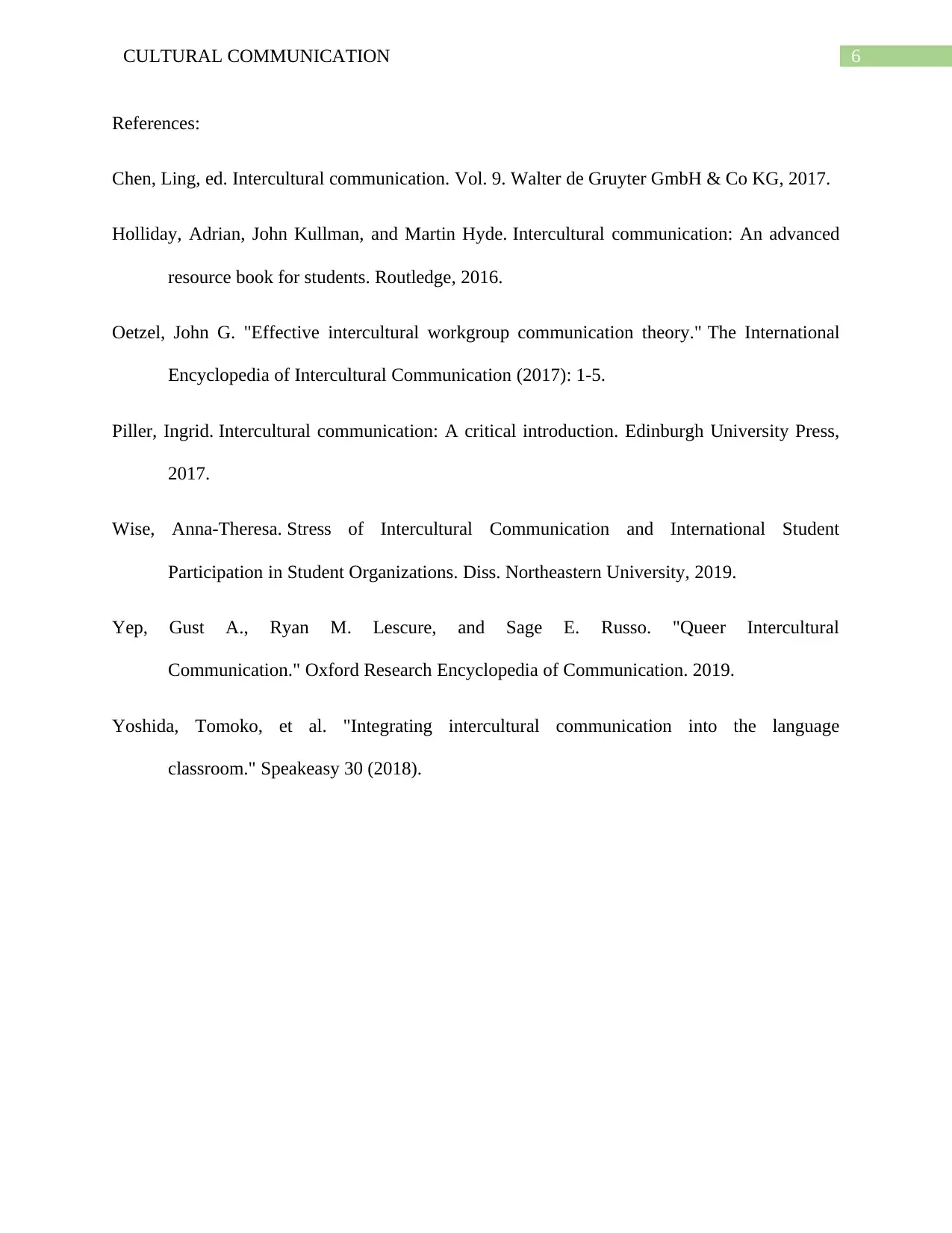
6CULTURAL COMMUNICATION
References:
Chen, Ling, ed. Intercultural communication. Vol. 9. Walter de Gruyter GmbH & Co KG, 2017.
Holliday, Adrian, John Kullman, and Martin Hyde. Intercultural communication: An advanced
resource book for students. Routledge, 2016.
Oetzel, John G. "Effective intercultural workgroup communication theory." The International
Encyclopedia of Intercultural Communication (2017): 1-5.
Piller, Ingrid. Intercultural communication: A critical introduction. Edinburgh University Press,
2017.
Wise, Anna-Theresa. Stress of Intercultural Communication and International Student
Participation in Student Organizations. Diss. Northeastern University, 2019.
Yep, Gust A., Ryan M. Lescure, and Sage E. Russo. "Queer Intercultural
Communication." Oxford Research Encyclopedia of Communication. 2019.
Yoshida, Tomoko, et al. "Integrating intercultural communication into the language
classroom." Speakeasy 30 (2018).
References:
Chen, Ling, ed. Intercultural communication. Vol. 9. Walter de Gruyter GmbH & Co KG, 2017.
Holliday, Adrian, John Kullman, and Martin Hyde. Intercultural communication: An advanced
resource book for students. Routledge, 2016.
Oetzel, John G. "Effective intercultural workgroup communication theory." The International
Encyclopedia of Intercultural Communication (2017): 1-5.
Piller, Ingrid. Intercultural communication: A critical introduction. Edinburgh University Press,
2017.
Wise, Anna-Theresa. Stress of Intercultural Communication and International Student
Participation in Student Organizations. Diss. Northeastern University, 2019.
Yep, Gust A., Ryan M. Lescure, and Sage E. Russo. "Queer Intercultural
Communication." Oxford Research Encyclopedia of Communication. 2019.
Yoshida, Tomoko, et al. "Integrating intercultural communication into the language
classroom." Speakeasy 30 (2018).
1 out of 7
Related Documents
Your All-in-One AI-Powered Toolkit for Academic Success.
+13062052269
info@desklib.com
Available 24*7 on WhatsApp / Email
![[object Object]](/_next/static/media/star-bottom.7253800d.svg)
Unlock your academic potential
Copyright © 2020–2025 A2Z Services. All Rights Reserved. Developed and managed by ZUCOL.





